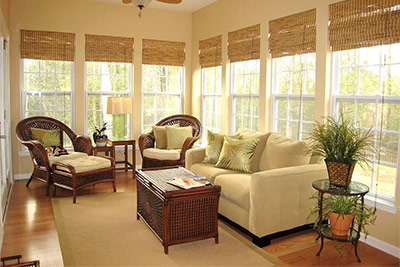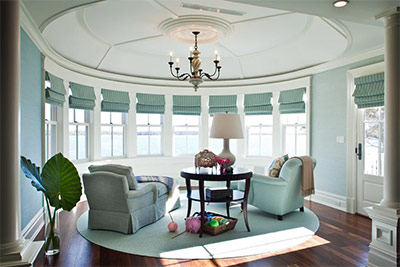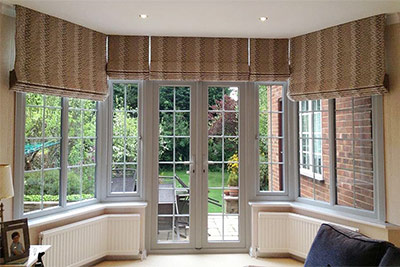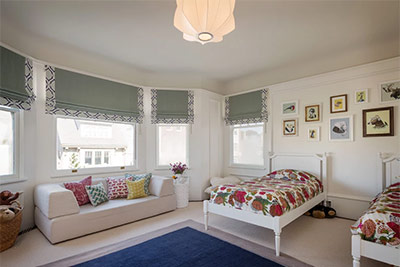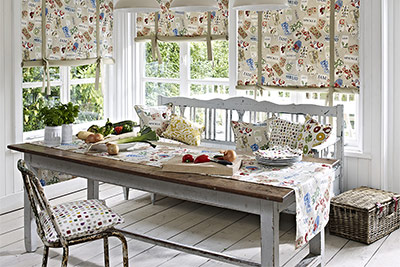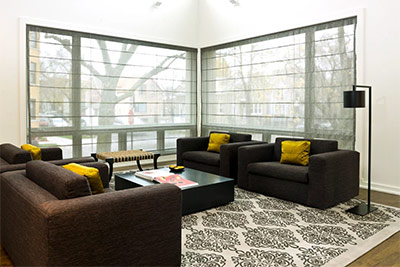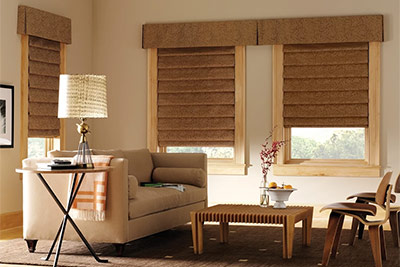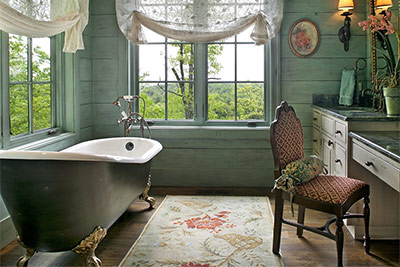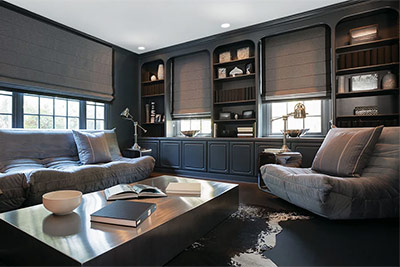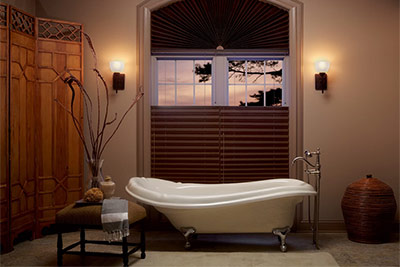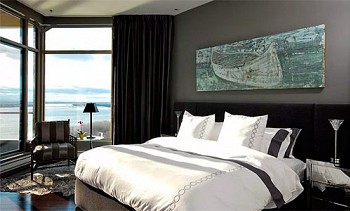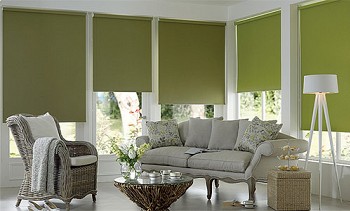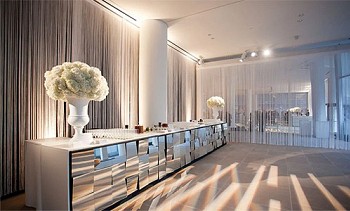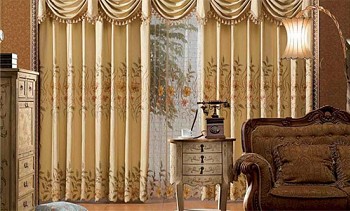Roman curtains in the interior - design, types, selection rules for color and design
Among the various short curtains, Roman ones stand out for their particular practicality and external aesthetics. They are in great demand, and manufacturers produce them in various forms: traditional and without frame, with convenient control mechanics, plain and with a pattern, from dense and translucent fabrics. A large selection of models and colors allows you to choose beautiful short curtains for the bedroom, living room and other rooms. Roman curtains harmoniously look in an interior of different styles: antique, classical, country and modern.
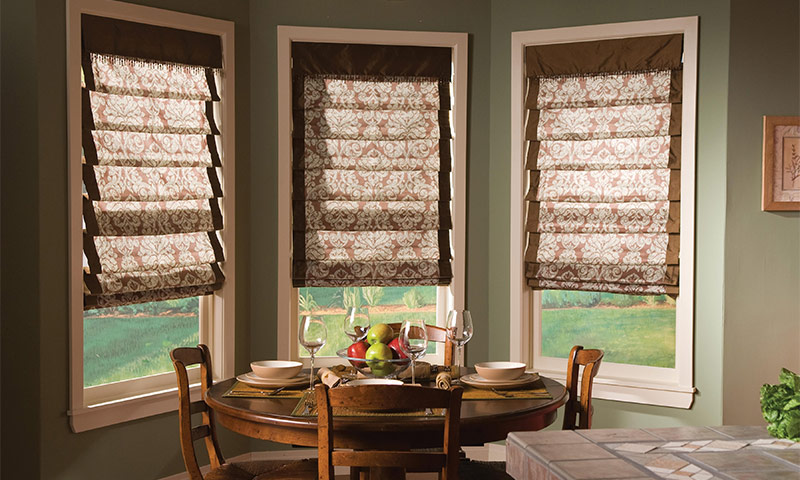
Content:
- Roman Curtain Design
- What are the types of Roman curtains
- What materials are used for the manufacture of Roman curtains
- Ways of fastening Roman curtains
- The right choice of color and design of the curtains
- In which cases it is advisable to use Roman curtains in the interior
- What curtains go well with Roman
- The use of Roman curtains in various rooms
- Photo ideas for using Roman curtains in the interior
Roman Curtain Design
The design of the very first Roman curtains consisted of a rectangular canvas on which the rings were fixed. They stretched the tape, which regulated the length of the paintings. Modern products differ from their ancestors in the convenient mechanism for lifting the web, otherwise they are just as practical and functional.

The design of modern products.
The design of the Roman curtains are such details:
Fabric - a rectangular base of a product from natural, synthetic or mixed fabric.
Kuliski - horizontal pockets in which the rods are attached.
Rods - the basis of the frame of the Roman curtain, thanks to which the canvas is folded into the same smooth folds. The rods are hard and soft, they are inserted into the wings, giving rigidity and shape to the canvas.
Weighting compound - a strip of plastic or metal, which is sewn along the lower tucked-up edge of the product for even tension of the fabric.

A weighting agent sewn into the fabric from the wrong side.
Lifting gear - This is a system of rings sewn from the inside of the canvas at the level of the wings and ribbons that are threaded into these rings.
Note: the Roman curtain in the interior has a more finished look if its lower edge is decorated with additional decor (tassels, fringe, glass beads) or has a graceful wavy edge.

Classic curtains with a decorated edge.
What are the types of Roman curtains
The main basic principle that is common to all types of Roman curtains is the way of management. The canvas rises and falls, folding in even folds, using a chain or lace. At the same time, it can be fixed at any convenient height. All Roman curtains are conventionally divided into several types according to the type of fold formation.

Types of Roman curtains.
Classic
The most common form is, of course, the classic one. The following symptoms are characteristic of it:
- when lifting the canvas smooth beautiful folds are formed, which are stacked on the lower edge of each other;
- when closing the window, the canvas is leveled, completely closing the window space, while it looks absolutely even;
- in the curtains of classic curtains are attached flexible rods that form fabric folds.
Classical Roman curtains in the interior of the living room, nursery or bedroom look elegant, simple and modern. Designers are happy to place them in the kitchen or bathroom, as even in the smallest room they occupy a minimum of space.

Classic look in the interior of the country kitchen.
Frameless
The main difference between frameless products from classical ones is the absence of horizontal rods. It is thanks to the rods in the classical model that smooth folds are formed.In the frameless model, the folds sag, creating a feeling of simplicity and harmony. Such curtains are great in the recreation area, as they contribute to relaxation and peace.

Frameless curtains in a cozy bay window.
Cascading
Such curtains, even when fully dissolved, have uniform horizontal folds that are cascaded. These Roman curtains are more festive and formal than classic, and more suitable for the living room.

Cascading draperies of wine cherry color in a baroque bedroom.
What materials are used for the manufacture of Roman curtains
Elegant Roman curtains may look different depending on the color, texture and pattern of the fabric from which they are sewn. For the hall, curtains are chosen from dense jacquard, satin, muslin with or without a pattern. The fabric does not let in sunlight and protects well from prying eyes, and also looks solemn even in a monophonic design.
For the library or the working area, translucent light fabrics are selected that close the window from prying eyes and transmit light. For example, flax or organza.
For the nursery and the bedroom, it is important that the curtains do not let in light while relaxing or sleeping. Therefore, for these rooms it is better to choose dense synthetic fabrics with minimal light transmission.

Blackout curtains in the bedroom.
The degree of light transmission of various types of fabric:
| Light-tight fabrics. | Vinyl, satin, blackout, canvas, jacquard, curtain fabric. | Pass from 0 to 10% of the light. |
| Translucent fabrics. | Flax, cotton, crepe satin, acrylic, acetate, muslin. | Pass from 25 to 40% of the light. |
| Transparent fabrics. | Veil, lace, organza. | Pass from 50 to 90% of the light. |
Cotton fabric
Cotton is a natural material that transmits light well, but is easily creased. It is rarely used in its pure form, most often with the addition of synthetic fibers, which improve the properties of cotton.

+ Cotton Fabric Benefits
- naturalness;
- inexpensive cost;
- bright colors;
- softness.

- Disadvantages of cotton fabric
- hesitates;
- shrinks after washing;
- burns out in the sun.
Linen fabric
Linen Roman curtains in the interior are used unpainted, in their natural light gray shade. Linen fabric is a noble natural material that is smooth to the touch.

+ The benefits of linen
- naturalness;
- high wear resistance;
- does not sit and does not fade after washing;
- does not crumple.

- Disadvantages of linen
- hesitates;
- does not possess form stability.
Linen curtains with pleasure are used in ethnic, Mediterranean, rustic interiors in kind.
Synthetic fabrics
Synthetic fabrics are often used for sewing curtains.

+ The benefits of synthetic fabrics
- do not crumple;
- differ in various textures and colors;
- possess various light transmission from 0% to 90%;
- have dust-repellent properties;
- Do not need frequent care.

- The disadvantages of synthetic fabrics
- some tissues are deformed by exposure to heat or easily ignited;
- may burn harmful substances when burned.

Frameless synthetic curtain with hard lambrequin.
Blended fabrics
A cloth woven from a mixture of natural and synthetic fibers is called blended. Such fabrics are very practical, have a wide range of items, differ in varying degrees of light transmission.

+ The benefits of mixed fabrics
- less wrinkled natural fabrics;
- do not shrink.

- Disadvantages of Blended Fabrics
- it is electrified;
- spools are formed.
Ways of fastening Roman curtains
Roman curtains can be mounted on a cornice (ceiling, side) or directly on the surface.
There are several mounting methods:
- the canvas is mounted on a cornice above a window opening;
- if there are several small windows on one wall, then the canvas is fixed to the frame of each window separately;
- if a large window consists of several wings, then for ease of opening, the curtains are attached separately to each wing;
- on the dormer-windows, the curtains are mounted in the ceiling and side cornices so that the canvas does not sag.
The Roman curtain in the interior is going both from the bottom up, and vice versa. You can fix the canvas at any height.

Different ways of attaching curtains (top-down and vice versa.)
On a note. The design of the curtains suggests that the canvas will be folded when lifting. But it does not disappear completely under the eaves, but remains visible at the level of the last fold.

Fastening the Roman curtains to the cornice.
The right choice of color and design of the curtains
The color of the long curtains is carefully selected to match the wallpaper, upholstered furniture or textile. After all, long curtains are an important decorative element, which occupies a significant place in the design of the room. With short curtains, a completely different story, because they take up little space, and when assembled, are almost invisible. If Roman curtains are combined on the window with other types of curtains, then they play a secondary role.
Most often they choose neutral colors for them:
- white;
- beige;
- light gray;
- sand.

Sand sheets to match the bedspread on the bed in combination with red curtains.

Neutral curtains in a white kitchen.
For minimalistic mono-interiors, the following options are suitable:
- canvas with a bright pattern;
- curtains with geometric patterns;
- canvas with a bright side edging.

Curtains with a bright pattern - this is a bright accent on the background of plain walls.
In which cases it is advisable to use Roman curtains in the interior
Practical Roman curtains in the interior of the living room look as organically as in the kitchen or on the balcony. This effect is achieved due to their exceptional versatility. But in some cases, a short curtain of the correct geometric shape is even preferable than a lush lambrequin or long curtains:
1. If a storage system is conceived in the restroom right under the window or a soft corner is located, then long curtains cannot be hung up, as they will interfere and constantly break off.

Successful use of short curtains.
2. If the kitchen window is located in the work area, and directly below it is a sink or table.

Frameless model in the interior of the kitchen.
3. When entrance doors with glass inserts and a window in a country house need to be decorated in the same style.

Textiles for the design of doors and windows.
4. When there are a lot of windows in the bedroom, when you use a long curtain on each of them, you may get the effect of an excess of textile design and overloaded design.

Bedroom decor with cascading roman curtains.
5. If we are talking about the design of a children's bedroom, then the use of Roman curtains is justified many times - when closed, they do not let in light, guaranteeing a good rest, but in the open state they completely expose the window and allow maximum light needed for classes or reading.

Tight curtains in the nursery.
What curtains go well with Roman
Designers use several ways to combine short and long curtains when decorating rooms:
1. The Roman curtain in the interior serves as protection from light and prying eyes, it is selected from a dense lightproof fabric. At the same time, the window is decorated with beautiful curtains, which play a major decorative role.
2. Short canvases complement the voluminous lambrequin in a single color scheme. The decorative function in this case lies on the lambrequin, and the Roman curtain is just the addition of a harmonious ensemble.

In combination with lambrequin.
3. Short and long curtains are selected in a single tone, and complement each other, creating a single ensemble.

A harmonious combination of Roman and long straight curtains.
The use of Roman curtains in various rooms
Bedroom
The traditional option of using long, voluminous curtains with a pattern or classic lambrequins in the bedroom can be easily replaced in a modern way - drape the windows with cascading or frameless Roman curtains.Roman curtains in the interior of the bedroom look soft and elegant, the main thing is to choose the right option.
To make the curtains blend in seamlessly with the room, choose thick cascading Roman curtains for windows that can be hung at different lengths, and use Japanese curtains of the same color instead of doors in the dressing room. The canvases will be in perfect harmony with each other, while they will successfully fulfill their functional load.

The combination of Japanese and Roman paintings in the bedroom.
Choose a fabric color that repeats the basic colors of the interior of the room.

Cotton classic roman draperies in the bedroom.
Roman curtains in the interior of the nursery is just a godsend. However, when choosing the shape and color of products, you need to take into account the age of the child and his preferences. The too colorful colorful curtains can bore the kid, and the teenager will be delighted with the laconic dark or bright plain draperies.

Plain curtains in the nursery.
Kitchen
The conditions of the kitchen space in an apartment and a house can be different: large and small area, convenient or forced arrangement of furniture, high and low ceilings. But despite this, short curtains will fit in any kitchen. Roman curtains in the interior of the kitchen do not take up too much space, do not create discomfort, and it’s enough to lift them during cooking or washing dishes so that they stay clean longer.

Curtains on doors and windows in the kitchen.
Living room
Since the living room is a meeting place for guests or gathering a family, the beauty of design plays an important role in it, and practicality goes by the wayside. Therefore, the textile design of the room is selected with particular care. At the same time, the principle of harmonious combination is used, and textiles are selected in the color of the environment. Or, on the contrary, they use the contrast principle, making a color accent on the curtains.

A harmonious combination of textile design and room design.

Contrasting draperies in the living room.
Roman curtains help to create a non-trivial and at the same time comfortable design. They gently emphasize the advantages of the room, do not reduce the space. They can easily be controlled even by a child. The variety of types and methods of decorating Roman draperies is quite large. Here are some more ideas for inspiration.












